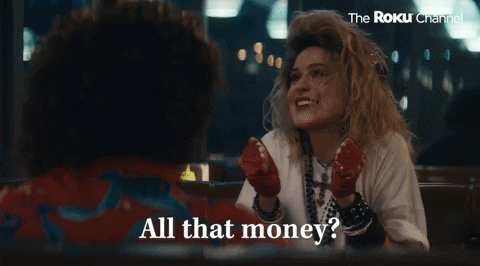📢 A Message from our Sponsor
Dub app raises $17M for first regulated copy trading platform
On Dub, you don't pick the stocks you want to invest in. You pick the people you want to copy, with portfolios based on hedge fund managers, investing experts, and even law makers.
When you copy a portfolio on Dub, you execute the same trades as them automatically. Dub’s team hopes this will make investing more transparent and accessible.
Dub is SEC-registered, member FINRA. All deposits are SIPC-insured.
Not investment advice. Full disclosures here.

Welcome back, Future Funder!
What makes money, well, money? Is it shiny metal? Government backing? Or just a shared agreement that something—anything—holds value?
Throughout history, people have traded using some truly bizarre currencies, like giant stones, tea bricks, and even squirrel pelts. Each one tells a fascinating story about trust, value, and adaptability—concepts that still apply today.
Bon a petit! 🧑🍳
🍽️ Main Course: 💰 Strange Currencies and the Lessons They Teach

Currency hasn’t always been about coins, cash, or Bitcoin. Throughout history, some of the quirkiest forms of money showcase human ingenuity and our ever-evolving understanding of value.
🪨 1. Rai Stones (Yap Island, Micronesia)
On the Micronesian island of Yap, rai stones—massive 12-foot crystalline limestone disks—served as money. Despite their size, these stones were never physically exchanged. Instead, ownership was transferred through verbal agreements.
Unique Form of Currency: Rai stones represent an early example of currency without physical transfer.
Collective Trust: The system relied entirely on the shared agreement of the Yapese people, ensuring that transactions were honored.
Lesson: Trust is the cornerstone of any monetary system.
The reliance on collective agreement mirrors modern-day digital transactions, where money is transferred electronically without any physical exchange.
☕ 2. Tea Bricks (China and Mongolia)
Tea bricks, made from compressed tea leaves, were once used as a form of currency in ancient China and Mongolia. Their use extended across Tibet, Central Asia, and even Siberia, continuing as late as World War II. Beyond their monetary value, tea bricks served as nourishment.
Lesson: Currency is often tied to utility.
Like tea bricks, items with intrinsic value—such as gold or other tangible goods—can provide security during uncertain times.
🐿️ 3. Squirrel Pelts (Medieval Finland)
In Medieval Finland, squirrel pelts became a widely traded form of currency. In the resource-scarce, frigid climate, fur was an essential commodity, valued for its ability to provide warmth and protection.
Practicality: Squirrel pelts were not just currency but a critical survival resource.
Adaptability: The scarcity of traditional resources led the community to prioritize and value furs as money.
Lesson: Money reflects what a community values most.
In disrupted or challenging economies, practical assets—like warmth-providing fur—often take the place of conventional currency, reinforcing the link between value and necessity.
⚓ 4. Whale Teeth (Fiji)
In Fiji, whale teeth (tabua) served as more than just currency; they were symbols of respect, peace, and deep cultural significance.
Ceremonial Role: Tabua were integral in important rituals, such as marriage agreements and conflict resolution.
Symbolic Value: Their worth went beyond practical use, rooted in the traditions and beliefs of the Fijian people.
Lesson: Perception drives value.
Whether it’s a diamond or a cryptocurrency, the value of an asset often depends on collective belief rather than its practical utility. This highlights the role of perception in shaping what we consider valuable.
⚱️ 5. Salt (Ancient Rome and Beyond)
Roman soldiers were paid in salarium—a salt allowance—underscoring salt’s essential role in food preservation. This connection is the origin of the modern word salary.
Lesson: Scarcity amplifies value.
Rare or limited resources often command higher prices due to their difficulty to obtain.
Examples include rare collectibles, precious metals, or limited-edition items.
Just like salt in ancient Rome, anything scarce can become extraordinarily valuable.
📈 What These Currencies Teach Us Today
Value Is Contextual: Rai stones worked because Yapese society agreed on their worth. The same applies to Bitcoin or even frequent flyer miles today.
Utility Matters: Tea bricks and salt doubled as valuable resources. In uncertain times, assets with practical use (like gold or food supplies) shine.
Trust Is Everything: Whether trading squirrel pelts or Venmo payments, financial systems crumble without trust. Transparency is key.
Scarcity Drives Demand: Whale teeth and limited-edition collectibles show that rarity fuels high value.
Adaptability Wins: From fur bartering to digital tokens, currency evolves with societal needs. Staying flexible in financial tools is crucial for modern investors.
🌟 What did we learn?
Trust Makes the World Go Round:
Currency functions because people believe in its value. Without trust, even gold or cash is just an object.
Utility + Scarcity = Resilience:
The most robust assets combine practical usefulness with limited availability, making them resilient over time.
Cultural Context Shapes Value:
What is considered “valuable” evolves. Recognizing these cultural shifts can lead to smarter financial decisions.
Modern Money Is Just as Weird:
From NFTs to Dogecoin, today’s financial experiments are the Rai stones and tea bricks of our era—symbols of changing perspectives on value.
The next time you swipe your card or buy Bitcoin, remember: money is whatever we agree it is. The more we understand its history, the better we can navigate its future.
Cheers to getting 1% better each week! 🎉
📢 A Message from Spotloan
Borrow up to $800 to cover unexpected expenses!
Spotloan can help with all of life's emergency expenses, from hospital bills to car emergencies to a sick pet or a broken cell phone.
🧙♀️ Your wish is our command
What did you think of today's email?
Thanks for reading.
Until next time!
Your friends @ Future Funders 🍽️
p.s. If you liked this newsletter, share it with your friends and colleagues here.

